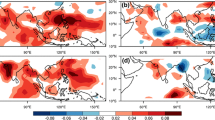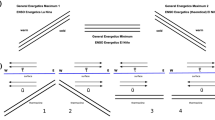Abstract
The boreal summer intraseasonal oscillation (BSISO) has two major activity centers, the northern Indian Ocean and tropical Western North Pacific, which dominate the monsoon intraseasonal variability over South Asia and East Asia, respectively. The spatial–temporal structures of BSISO over the Indian Ocean (10°S–30°N, 60°–105°E) (IOISO) and Western Pacific (10°S–30°N, 105°–150°E) (WPISO) are examined by corresponding the leading modes of daily OLR and 850-hPa zonal wind (U850). The IOISO features a northeastward propagation with a 30–45 days energy peak and the first principal component (PC1) has maximum variance in May, while the WPISO propagates northward with a broad spectral peak on 10–60 days and the PC1 has maximum variance in August. Because of the large regional differences, two regional indices, the IOISO index and WPISO index, are defined by their corresponding first two leading PCs. The combined IOISO–WPISO index captures about 30 % (10 %) of U850 (OLR) daily variance over the entire IO–WP region (10°S–30°N, 60°–150°E), which doubles that captured by the Madden–Julian Oscillation (MJO) index (Wheeler and Hendon 2004) and is 50 % higher than that captured by the BSISO index (Lee et al. 2013). The combined index also shows superior performance in representing biweekly and pentad-mean variations in the Asian-Pacific summer monsoon region (north of 10°N). The predictability/prediction skill and simulated principal modes of two regional BSISO indices are explored by using data derived from the Intraseasonal Variability Hindcast Experiment project. The major regional modes are reasonably well captured, but the forecasted fractional variances of the leading modes and variability center’s locations exhibit significant deficiencies. The multi-model mean estimate of the predictability is 40–45 days for the IOISO index, whereas 33–37 days for the WPISO index. The less predictable WPISO is likely due to the existence of its significant biweekly component. The multi-model mean prediction skill is significantly higher with large initial amplitude (~20 days for two indices) than that with small initial amplitude (~11 days), suggesting that the prediction for development of BSISO is much more difficult than the prediction for mature BSISO disturbances’ propagation.











Similar content being viewed by others
References
Bellenger H, Duvel JP (2007) Intraseasonal convective perturbations related to the seasonal march of the Indo-Pacific monsoons. J Clim 20:2853–2863
Chou C, Hsueh Y (2010) Mechanisms of northward-propagating intraseasonal oscillation—a comparison between the Indian Ocean and the western north Pacific. J Clim 23:6624–6640
Fu X, Wang B, Waliser D, Tao L (2007) Impact of atmosphere–ocean coupling on the predictability of monsoon intraseasonal oscillations. J Atmos Sci 64:157–174
Fu X, Wang B, Bao Q, Liu P, Lee JY (2009) Impacts of initial conditions on monsoon intraseasonal forecasting. Geophys Res Lett 36:L08801. doi:10.1029/2009GL037166
Fu X, Wang B, Lee JY, Wang W, Gao L (2011) Sensitivity of dynamical intraseasonal prediction skills to different initial conditions. Mon Wea Rev 139:2572–2592
Goswami BN, Ajayamohan RS, Xavier PK, Sengupta D (2003) Clustering of synoptic activity by Indian summer monsoon intraseasonal oscillations. Geophys Res Lett 30:1431
Jiang X, Li T, Wang B (2004) Structures and mechanisms of the northward-propagating boreal summer intraseasonal oscillation. J Clim 17:1022–1039
Kanamitsu M et al (2002) NCEP dynamical seasonal forecast system 2000. Bull Am Meteorol Soc 83:1019–1037
Kemball-Cook S, Wang B (2001) Equatorial waves and air–sea interaction in the boreal summer intraseasonal oscillation. J Clim 14:2923–2942
Kikuchi K, Wang B (2009) Global perspectives of the quasi-biweekly oscillation. J Clim 22:1340–1359
Kim HM, Kang IS (2008) The impact of ocean–atmosphere coupling on the predictability of boreal summer intraseasonal oscillation. Clim Dyn 31:859–870
Kim HM, Kang IS, Wang B, Lee JY (2008) Interannual variations of the boreal summer intraseasonal variability predicted by ten atmosphere-ocean coupled models. Clim Dyn 30:485–496
Krishnamurthy V, Shukla J (2008) Seasonal persistence and propagation of intraseasonal patterns over the Indian monsoon region. Clim Dyn 30:353–369
Lawrence D, Webster PJ (2002) The boreal summer intraseasonal oscillation and the South Asian monsoon. J Atmos Sci 59:1593–1606
Lee JY, Wang B, Wheeler M, Fu X, Waliser D, Kang IS (2013) Realtime multivariate indices for the boreal summer intraseasonal oscillation over the Asian summer monsoon region. Clim Dyn 40:493–509
Lee SS, Wang B, Waliser D, Neena JM, Lee JY (2015) Predictability and prediction skill of the boreal summer intraseasonal oscillation in the Intraseasonal Variability Hindcast Experiment. Clim Dyn. doi:10.1007/s00382-014-2461-5 published online
Liebmann B, Smith CA (1996) Description of a complete (interpolated) outgoing longwave radiation dataset. Bull Am Meteor Soc 77:1275–1277
Liebmann B, Hendon H, Glick J (1994) The relationship between tropical cyclones of the western Pacific and Indian Oceans and the Madden–Julian Oscillation. J Meteor Soc Jpn 72:401–412
Lin H, Brunet G, Derome J (2008) Forecast skill of the Madden–Julian Oscillation in two Canadian atmospheric models. Mon Wea Rev 136:4130–4149
Maloney E, Hartmann D (2001) The Madden–Julian Oscillation, barotropic dynamics, and North Pacific tropical cyclone formation. Part I: observations. J Atmos Sci 58:2545–2558
Moon JY, Wang B, Ha KJ, Lee JY (2013) Teleconnections associated with Northern Hemisphere summer monsoon intraseasonal oscillation. Clim Dyn 40:2761–2774
Neena JM, Jiang X, Waliser D, Lee JY, Wang B (2014a) Eastern Pacific Intraseasonal Variability: a predictability perspective. J Clim 27:8869–8883
Neena JM, Lee JY, Waliser D, Wang B, Jiang X (2014b) Predictability of the Madden-Julian Oscillation in the Intraseasonal Variability Hindcast Experiment (ISVHE). J Clim 27:4531–4543
Pegion K, Kirtman BP (2008) The impact of air–sea interactions on the predictability of the tropical intraseasonal oscillation. J Clim 21:5870–5886
Sengupta D, Senan R, Goswami BN (2001) Origin of intraseasonal variability of circulation in the tropical central Indian Ocean. Geophys Res Lett 28:1267–1270
Shukla RP (2014) The dominant intraseasonal mode of intraseasonal South Asian summer monsoon. J Geophys Res 119:635–651
Suhas E, Neena JM, Goswami BN (2013) An Indian monsoon intraseasonal oscillation (MISO) index for real time monitoring and forecast verification. Clim Dyn 40:2605–2616
Teng H, Wang B (2003) Interannual variations of the boreal summer intraseasonal oscillation in the Asian-Pacific region. J Clim 16:3572–3584
Waliser D, Jin K, Kang IS, Stern WF et al (2003) AGCM simulations of intraseasonal variability associated with the Asian summer monsoon. Clim Dyn 21:423–446
Wang B (1992) The vertical structure and development of the ENSO anomaly mode during 1979–1989. J Atmos Sci 49:698–712
Wang B, Rui H (1990) Synoptic climatology of transient tropical intraseasonal convection anomalies. Meteor Atmos Phys 44:43–61
Wang B, Xie X (1996) Low-frequency equatorial waves in vertically shear flow. Part I: stable waves. J Atmos Sci 53:449–467
Wang B, Xie X (1997) A model for the boreal summer intraseasonal oscillation. J Atmos Sci 54:72–86
Wheeler M, Hendon HH (2004) An all-season real-time multivariate MJO index: development of an index for monitoring and prediction. Mon Wea Rev 132:1917–1932
Yim SY, Wang B, Liu J, Wu Z (2014) A comparison of regional monsoon variability using monsoon indices. Clim Dyn 43:1423–1437
Zhang C, Gottschalck J, Maloney ED, Moncrieff MW, Vitart F, Waliser D, Wang B, Wheeler MC (2013) Cracking the MJO nut. Geophys Res Lett 40:1223–1230
Zhu B, Wang B (1993) The 30–60 day convection seesaw between the tropical Indian and western Pacific Oceans. J Atmos Sci 50:184–199
Acknowledgments
This work was jointly supported by the NOAA/MAPP project Award number NA10OAR4310247, APEC climate center (APCC), and the National Research Foundation (NRF) of Korea through a Global Research Laboratory (GRL) grant of the Korean Ministry of Education, Science and Technology (MEST, #2011-0021927). BW acknowledges support from NOAA/ESS program, under Project NA13OAR4310167. This is publication No. 9433 of the SOEST, publication No. 1123 of IPRC, and publication No. 052 of Earth System Modeling Center (ESMC).
Author information
Authors and Affiliations
Corresponding author
Rights and permissions
About this article
Cite this article
Lee, SS., Wang, B. Regional boreal summer intraseasonal oscillation over Indian Ocean and Western Pacific: comparison and predictability study. Clim Dyn 46, 2213–2229 (2016). https://doi.org/10.1007/s00382-015-2698-7
Received:
Accepted:
Published:
Issue Date:
DOI: https://doi.org/10.1007/s00382-015-2698-7




